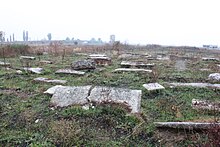Jewish cemetery (Vidin)
Coordinates: 44 ° 0 '27.3 " N , 22 ° 53' 38.8" E
The Jewish cemetery in Vidin is an abandoned Jewish cemetery in the town of Vidin in northwestern Bulgaria . Most of the graves in the cemetery, established in 1879, date from the 20th century. After a number of looting since 1980, the remaining gravestones are largely overgrown with grass and bushes.
Ashkenazi Jews settled in Vidin and other places on the lower Danube from the 11th to 13th centuries . After their expulsion from the Iberian Peninsula in 1492, Sephardic Jews came to the areas of the Balkans under Ottoman rule. From the 16th century, the Sephardim dominated the Jewish communities in Bulgaria. In 1585 there were 31 Jewish households in Vidin; the converted 217 Jews from Vidin formed one of the larger groups in the area of today's Bulgaria. Architectural remains of Jewish houses or synagogues as well as cemeteries throughout the country from the period before the mid-19th century have not been preserved.
The Vidin cemetery is located on the northeastern outskirts of the city on an open space that is bordered to the west by Car-Simeon-Weliki-Straße. It is the continuation of the Panonia Boulevard coming out of the city and at this point joins the road coming from the Danube Harbor and leading to the E79 motorway, which delimits the area in the north. The preserved tombstones are roughly in the middle of the area overgrown with tall grass and in places bushes. About 100 meters to the west - closer to Car-Simeon-Weliki-Straße - some Christian gravestones have been preserved, which are of similar material and condition as the Jewish ones, but hidden even more under vegetation. The area is not fenced in and unused, and there is no path to the graves from either side.
The size information comes from a Jewish-American commission that visited the cemetery in 2001. According to this, there were 1056 tombstones ( Mazewa ) on an area of 1.85 hectares at that time . The oldest tombstone found is dated 1880, most date from the mid-20th century, and the youngest known burial took place in 1976. There were standing tombstones and recumbent tombstones from the Ashkenazi and Sephardic tradition made of granite, marble and limestone. The inscriptions were in Bulgarian, Hebrew and Yiddish .
After the Second World War , most of the Jews emigrated to Israel. Around 25 Jews were still living in Vidin at the turn of the millennium. This small community has neither the facilities to look after the cemetery nor the ruins of the synagogue in the city center. The looting, which began in 1980, made the Vidin cemetery, according to a description from 2001, the most vandalized Jewish cemetery in the country . No tombstones are upright anymore, the tombstones are partially broken, the pictures of the deceased attached to them in round frames have almost all been chipped off. The condition has continued to deteriorate since then. Another part of the tombstones photographed in 2001 has disappeared.
Web links
- Jewish Historic Monuments and Sites in Bulgaria. United States Commission for the Preservation of America's Heritage Abroad, 2011, pp. 68-70
Individual evidence
- ^ Stanford J. Shaw: The Jews of the Ottoman Empire and the Turkish Republic. (New Perspectives on Jewish Studies) New York University Press, 1991, pp. 38f
- ^ Jewish Historic Monuments and Sites in Bulgaria. ( Memento of December 2, 2016 in the Internet Archive ) United States Comission for the Preservation of America's Heritage Abroad, 2011, p. 18


